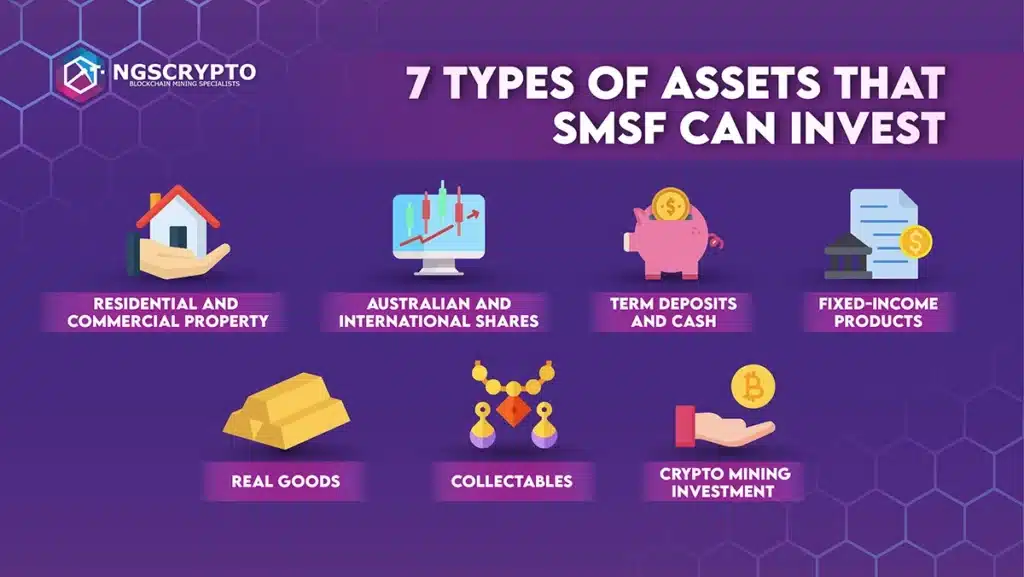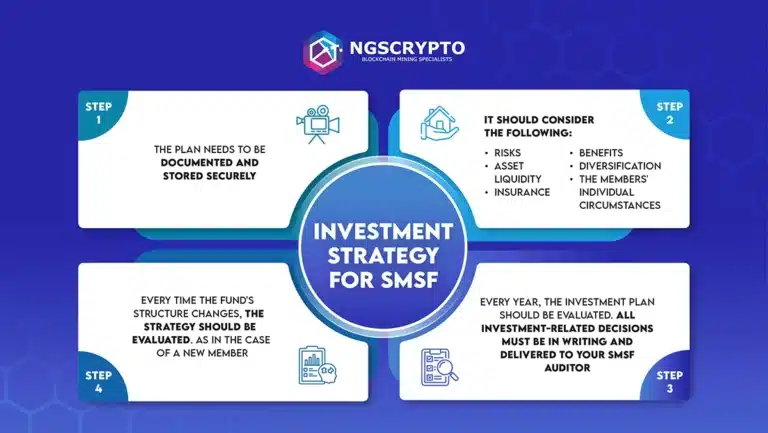NGS Crypto is an Authorised Reseller of NGS Group Blockchain Mining Packages
NGS Crypto is an Authorised Reseller of NGS Group Blockchain Mining Packages


Written by Katya Richardson
Share this article
Many Australians are now actively managing their retirement funds with a self-managed super fund (SMSF). Why? because SMSFs offer more freedom and investment choices for a wider variety of assets compared to regular superannuation funds.
Indeed, along with the freedom and flexibility SMSFs offer comes a crucial inquiry: What are the permissible investment options for an SMSF? In this comprehensive article, we delve into the spectrum of investment choices available to SMSFs.
We explore the considerations essential to prudent investing, delve into crafting an effective SMSF investment strategy, and provide insights into the process of formulating such a strategy. Your quest for a detailed understanding of SMSF investment possibilities begins right here.

Here is a list of the different types of investments that a self-managed super fund may make:
While investing in real estate through your SMSF is a viable option, it’s imperative to acquaint yourself with the rules, as these rules diverge significantly from the conventions of regular superannuation funds. Usual rules that apply to regular superannuation funds:

Lenders often allow self-managed super funds to borrow 70-80% of a property’s value. However, they typically require the SMSF to have a company as trustee instead of individuals.
Shares, also known as stocks or equities, represent ownership in a company. When you purchase shares of a company, you essentially become a shareholder and own a portion of that company. Shareholders have the potential to benefit from the company’s profits and growth.
According to the Australian Taxation Office (ATO), listed shares are the most popular asset class for SMSFs. Putting money into the stock market can be highly profitable, but it’s crucial to conduct your due diligence.
Investing in Shares with Your SMSF:
Many SMSF trustees invest in shares because they can grow in value and pay you dividends (like interest on your investment).
Here’s how it usually works:
What to Think About:
You can invest a portion of your superannuation balance in a term deposit for a certain amount of time at a specified rate of return. The majority of banks provide term deposits designed exclusively for self-managed super funds.
As long as you don’t take your money out of the account before the term is over, this low-risk technique enables you to earn higher interest than the majority of savings accounts. However, for money that is immediately available, a high-interest savings account is still helpful.
One popular form of fixed-income product is bonds, which are often less volatile than stocks.
When you purchase a bond, you are actually lending money to the company issuing it. This company guarantees to pay interest at a specific rate and to refund the principal on the bond’s maturity date.
Government bonds, which are thought to be the safer investment because the likelihood of default is low, are available on the bond market alongside business bonds.
This category of “real” assets includes a variety of raw resources, including metals like gold and silver as well as agricultural and energy products.
The independence of commodities’ returns from those of stocks, real estate, and bonds attracts investors. Commodities can also be used as an inflation hedge because they are one of the few asset groups that perform well when inflation is rising.
These include things like jewels, antiques, automobiles, coins, memorabilia, and wine. But after 2016, stricter regulations were implemented, and now fewer SMSFs are making collectibles investments. Before including any collectibles in your portfolio, be sure you are aware of the rules.
As technology advances, many people are entering the world of crypto mining via their Self Managed Super Funds. This novel strategy not only provides a unique way to diversify one’s portfolio, but it also allows individuals to tap into the possibilities of an exponentially growing digital economy.
Crypto mining could be the thrilling business opportunity you’ve been looking for, if you’ve ever thought about diversifying your SMSF assets. Many people are already profiting from it, and they are using technology to its fullest potential.

Your SMSF’s investing strategy should achieve both your retirement and investment goals.

In the world of self-managed super funds and their investment choices, knowledge and careful planning are vital. As you explore various investment options for your SMSF, remember that a well-thought-out strategy, regular assessment, and compliance with legal obligations are essential for achieving your retirement objectives.
Whether you’re considering traditional investments or newer opportunities like cryptocurrency mining, staying informed and making informed decisions will empower you to maximize the potential of your SMSF, securing a better financial future for you and your family.
The information presented on this website is general information only. It should not be taken as constituting professional advice from the website owner – NGS Crypto PTY LTD (NGS Crypto). Any information regarding past performance and returns contained on this website should not be construed or interpreted as a prediction or opinion as to future performance and returns. NGS Crypto is not a financial adviser. All views and observations expressed by NGS Crypto on this website are for information purposes only, are general in nature and should not be treated as investment or financial advice of any kind.
NGS Crypto is an authorised reseller of NGS Group blockchain mining packages. The information presented on this website (https://ngscrypto.com) is general information only. It should not be taken as constituting professional advice from the website owner – NGS Crypto PTY LTD (NGS Crypto). Any information regarding past performance and returns contained on this website should not be construed or interpreted as a prediction or opinion as to future performance and returns. NGS Crypto is not a financial adviser. All views and observations expressed by NGS Crypto on this website are for information purposes only, are general in nature and should not be treated as investment or financial advice of any kind. Before making an investment in crypto assets, you should consider seeking independent legal, financial, taxation or other such professional advice to check how the information on this website relates to your unique circumstances. NGS Crypto is not liable for any loss caused, whether due to negligence or otherwise arising from the use of, or reliance on, the information provided directly or indirectly, by use of this website. You can view our full terms & conditions by clicking here.
NGS Crypto is not affiliated, associated, authorized, endorsed by, or in any way officially connected with this NGS Super (ABN 73 549 180 515).
© 2024 NGS Crypto
NGS Crypto is an Authorised Reseller of NGS Group
| Cookie | Duration | Description |
|---|---|---|
| cookielawinfo-checkbox-analytics | 11 months | This cookie is set by GDPR Cookie Consent plugin. The cookie is used to store the user consent for the cookies in the category "Analytics". |
| cookielawinfo-checkbox-functional | 11 months | The cookie is set by GDPR cookie consent to record the user consent for the cookies in the category "Functional". |
| cookielawinfo-checkbox-necessary | 11 months | This cookie is set by GDPR Cookie Consent plugin. The cookies is used to store the user consent for the cookies in the category "Necessary". |
| cookielawinfo-checkbox-others | 11 months | This cookie is set by GDPR Cookie Consent plugin. The cookie is used to store the user consent for the cookies in the category "Other. |
| cookielawinfo-checkbox-performance | 11 months | This cookie is set by GDPR Cookie Consent plugin. The cookie is used to store the user consent for the cookies in the category "Performance". |
| viewed_cookie_policy | 11 months | The cookie is set by the GDPR Cookie Consent plugin and is used to store whether or not user has consented to the use of cookies. It does not store any personal data. |